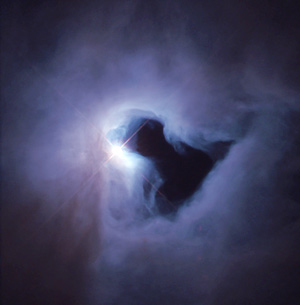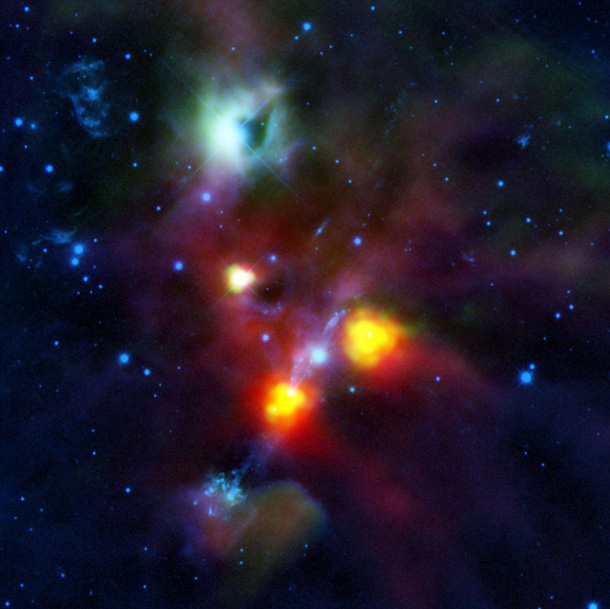Space is black. I mean, duh, right? But really, it’s black because it’s almost entirely empty, so even with stars scattered around, there’s nothing to light up.
 But some parts of space are bright: clouds of gas can be lit up by nearby stars, making them glow. However, just to make things more fun, there can be thicker patches of dust mixed in that block the light from the stars and gas behind them. We see lots of those, they’re pretty common. But there’s yet another “however”: that dust only blocks the visible light. In the infrared, that dust should itself glow because it’s warm.
But some parts of space are bright: clouds of gas can be lit up by nearby stars, making them glow. However, just to make things more fun, there can be thicker patches of dust mixed in that block the light from the stars and gas behind them. We see lots of those, they’re pretty common. But there’s yet another “however”: that dust only blocks the visible light. In the infrared, that dust should itself glow because it’s warm.
NGC 1999 – seen here in a famous Hubble picture – has all these ingredients. It’s a thick region of gas and dust. Stars are being born in and around it, brightening it with their reflected light (as seen in the image; the star V380 Orionis on the left is lighting up the surrounding space junk) as well as warming it up and making it glow on its own. Even so, the oddly-shaped patch to the right was thought to be an unusually dense blob of dust, blocking the light from gas on the other side of it from us.
A lot of the time those dense spots are where stars are being born, and the only way to see them is in the infrared. So astronomers pointed the European space-based Herschel infrared observatory at it, fully expecting to see the whole thing glowing with perhaps a nascent star forming in the dark blob. But that’s not quite how it worked out…

Here’s the Herschel image they got. See that green blob near the top? That’s the part you can see in the Hubble image. In fact, it looks an awful lot like the Hubble shot, with the star V380 Orionis on the left, lots of glowy stuff, and that dark spot just to the right of it…
Wait, what? That spot is still dark? In the far infrared? That can’t be right. Even if it were only a few degrees above absolute zero it should be glowing at least a little bit.
So the astronomers followed up with more observations from the ground, and found something astonishing: it really is a hole, an actual empty region in the middle of a dense cloud! That’s the exact opposite of what they expected. There’s no there there. What could have done this?
It turns out that the fault may lie in the stars themselves. Many times, when stars are born, they form twin beams of material that blast out of their poles. That must have happened here; there are plenty of very young stars in this volume of space. It’s likely that one (or maybe more) of them switched on beams like this. The furious torch of matter and energy punched its way into the surrounding nebulosity, creating this tunnel right on through to the other side. I’ll note it’s unlikely that V380 Orionis had much or anything to do with carving this hole; it’s actually well past the age where it would make such beams. That only happens with stars that are only a million or so years old at most. V380 is already a stable star, well past that age, so it’s probably innocent.
NGC 1999 is a familiar object to a lot of astronomers. The odd shape of the dark spot (it’s always reminded me of a Shuttle Orbiter) makes it fairly iconic. So this news is a bit of a shake up; I was delighted when I read it. I love it when we see something new under any circumstances, but something we thought we knew – something we could almost dismiss as being well-enough understood that it was no big deal – to find out it’s actually unique and wholly unexpected… well, that’s just awesome.
Surprises in science are the best results you can get. Nothing makes scientists happier than having to turn their pencils around and use the other end.
Credits: NASA and The Hubble Heritage Team (STScI), ESA/HOPS Consortium